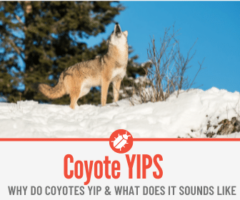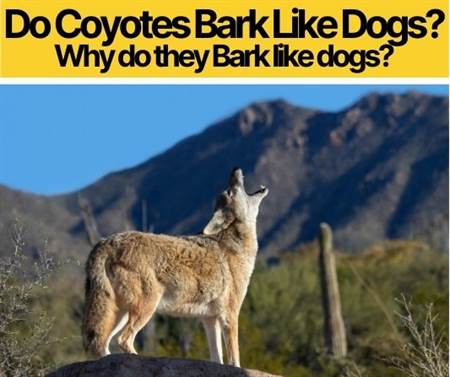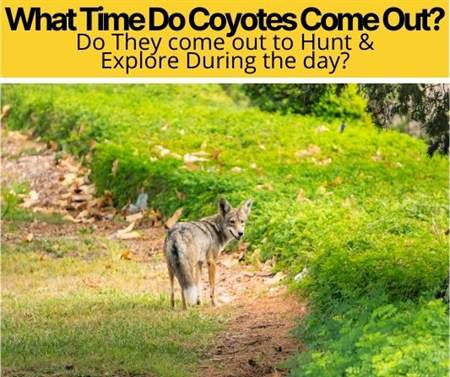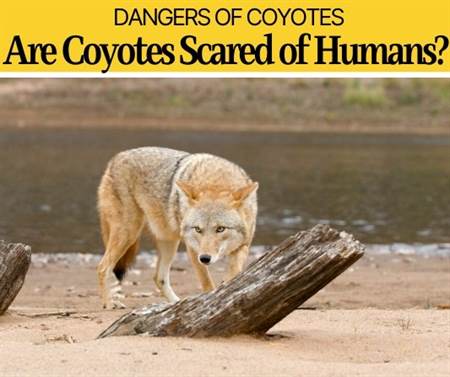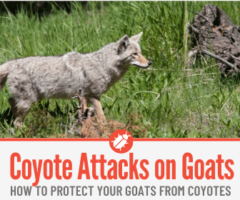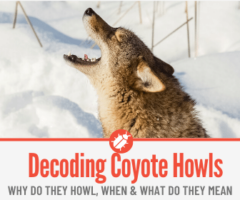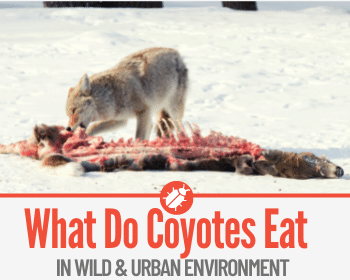 Coyotes have a reputation as notorious hunters, killing deer and domestic pets. But, this image is not exactly correct.
Coyotes have a reputation as notorious hunters, killing deer and domestic pets. But, this image is not exactly correct.
While still a hunter, the coyote is mostly a scavenger, willing to make a meal out of almost anything.
In this guide you will learn:
- What Coyotes prefer to Eat, both in the Wild & City,
- What Animals Coyotes eat & when they eat them,
- How do Coyotes Hunt,
- If hungry Coyotes can Attack a Human.
Coyotes are scavengers in the purest form. Being a very opportunistic animal, they will eat whatever they can find, including anything from insects to trash.
For example, the desert coyote will eat anything it can find, ranging from cactus fruit to mesquite beans to flowers, insects, rodents, lizards, snakes, and more. Get the idea?
Anything that is even slightly edible is fair game for the coyote.
What Do Coyotes Eat?
Coyotes are omnivores, meaning they will eat both plants and animals, although they definitely prefer meat over plants and fruits.
Their opportunistic and scavenger nature leads them to eat almost anything they can find, meaning their diet can include any of the following: small rodents, birds, insects, fruits, berries, fish, frogs, and even large animals.
Their ability to eat almost anything benefits them especially in more urban areas or harsh climates.
A coyote’s diet is determined mainly by his location, environment, and season.
The coyote’s primary source of food (making up three-fourths of their diet) is small rodents, rabbits, squirrels, and other small mammals.
With their normal habitat (plains, forests, and mountains), coyotes find plentiful sources of their favorite small animals.
When their main source of food is scarce, coyotes will turn to other food options including deer, livestock, poultry, garbage, and sometimes even pets (although mostly cats).
Below is a list of the coyote’s most common food sources and information on how and when the coyote eats each food source.
Mice
Mice are one of the coyote’s favorite animals to eat, and they make up a large majority of the coyote’s diet.
Coyotes eat so many rodents, mainly mice, that studies have shown a noticeable increase in rodent population when the coyote population is removed or diminished.
Rabbits
Being a small mammal, rabbits are on the list of a coyote’s favorite meal.
Interestingly, scientists have found that rabbit and rodent remains make up about half of the prey items in coyote scat.
Coyotes benefit farmers and their crops by limiting rabbit populations.
Rats
Rats and mice make up most of the coyote’s diet in both rural and urban areas.
In urban areas, coyotes take advantage of garbage cans and trash dumps, knowing the garbage will attract mice and rats.
Birds
Coyotes are known to eat birds, although they do not regularly hunt birds like they do land mammals because birds are not easy prey.
That said, coyotes will eat birds whenever they are available to reach, which is often when the bird is lying on the ground injured or dying.
Coyotes do prefer larger land birds that are slower and make their nests on the ground.
Some other forms of flying birds that coyotes eat include hawks (although quite rare), owls, dead birds, and bird eggs.
Snakes
Coyotes will sometimes eat snakes. The coyote will usually attack and eat a snake if it is threatening a pup or if there is limited food available to them.
Wondering how the coyote manages to kill and eat the snake without being bitten?
They will tease the snake until it stretches his neck out towards the coyote.
Then, the coyote will bit the snake’s head, and shake it back and forth in its mouth until the snake’s head snaps off.
Squirrels
Coyotes eat squirrels quite often. Even though the squirrel is a quick climber and a fast runner, he is often an easy prey for the coyote.
To avoid being captured by the coyote, the squirrel will either scamper up a tree or run away.
While the squirrel’s top speed is 20 miles per hour, the coyote can run up to 42 miles per hour, making the squirrel an easy catch.
Deer
The common presence of deer hair in coyote scat indicated that the deer is one of the coyote’s most common sources of food.
Throughout the entire year, coyotes will scavenge for deer carcasses, but they usually hunt deer mainly in the spring and in the winter.
Interestingly, how often the coyote eats deer depends on the weather. Studies have shown that coyotes are less likely to hunt deer in mild winter seasons when there is little snow.
In these type of winters, coyotes will often switch to a smaller prey, such as the snowshoe hare, because it is easier to track and kill.
It seems that coyotes prefer larger amounts of snow when hunting in the winter because the snow slows down and exhausts the deer more quickly.
In the spring, coyotes hunt deer fawns more often than adult deer. Additionally, when in an area that does not include wolves or bears, coyotes are often the highest source of fawn mortality.
When hunting in a pack, coyotes will often hunt adult deer in the spring and fall as well.
Fish
Coyotes will eat almost any kind of fish they can find. Anything from shellfish to bass to bluegill is fair game for the coyote.
Especially when they’re are not competing with bears, coyotes will find a large source of their diet in lakes and rivers, eating all sorts of fish and water creatures.
The only aquatic animal the coyote will not eat is the toad.
Foxes
Even though coyotes do not actively hunt foxes, but they will sometimes eat a fox.
As natural enemies, foxes and coyotes don’t often cross paths.
However, with more urban civilization pushing into both animal’s territories, sometimes a fox will enter the coyote’s territory.
If this happens, the coyote will kill and eat the fox.
A coyote will kill and eat a fox if necessary to stay alive.
Raccoons
Coyotes eat raccoons, both adults and juveniles, quite often.
Since both the raccoon and the coyote are nocturnal, raccoons make an easy and tasty meal for hungry coyotes.
While coyotes will eat raccoons, it is important to note that raccoons are not the most primary source of a coyote’s meal.
Skunks
Because coyotes are scavengers, they will eat skunks, although not very frequently.
Because of the skunk’s scent defense system, coyotes do not often hunt skunks but will eat them if other food options are limited or nonexistent.
Turkeys
Coyotes are one of the biggest predators for wild turkeys.
They’ll target everything from eggs in the nest to younglings to an adult turkey.
While the turkey is not the coyote’s most common meal, it is one of the coyote’s favorites.
Cats
Coyotes have been known to eat cats, both domestic and feral.
With more coyotes living in urban environments, they have become more accustomed to humans and thus more bold when attacking animals such as cats.
Even though cats are not part of a coyote’s normal diet, as scavengers, coyotes will eat cats—even if in an enclosed are (like a fenced yard).
According to a study in Arizona, 78% percent of the coyote attacks on cats happened between 10 at night and 5 in the morning.
Additionally, a study in Denver claimed that 20% of the coyote attacks on pets (the study didn’t note the number of cats versus dogs) happened in a fenced in area.
Most of the time, coyotes attack kittens and older, weaker cats because they are easier prey.
However, full-grown cats have become a coyote’s meal from time to time.
Dogs
Coyotes have been known to eat dogs, both domestic and feral. Dogs hower do not make up a major or even common part of a coyote’s diet.
However, being a scavenger, the coyote will eat a dog when other food is scarce or when the dog is an easier prey.
According to a variety of studies, coyotes are more likely to attack dogs during the late fall, early winter, and late spring instead of during the warmer months of the year.
A study done in the Chicago metropolitan area reported that almost 30 different dog breeds have been attacked by coyotes. While small dogs were the most commonly attacked, medium and large breeds had experienced a few attacks.
Interestingly, the smaller dogs were usually attacked by lone coyotes whereas the larger dogs were usually attacked by two or more coyotes.
Do Coyotes Eat Dead Animals?
Because the coyote is a scavenger at heart, he has no aversion to eating dead animals.
In fact, scientists believe that coyotes prefer eating dead animals (for example road kill) more than they prefer hunting down the animal and killing it.
While the coyote has been known to track and kill deer, scientists estimate that the coyote prefers to eat deer that are already dead or dying.
What Plants Do Coyotes Eat?
Even though the coyote prefers to eat meat, his diet does consist of plenty of plants, fruits, and vegetables.
The coyote will eat berries, watermelons, grapes, figs, apples, pears, cactus fruits, mesquite beans, flowers, and basically any other plant they can get a hold of.
In fact, the coyote eats the most berries, plants, and fruits in the autumn when it is harvest season and fruits are falling off of the branches.
How Often Do Coyotes Eat?
While the coyote generally needs to eat 2 to 3 pounds of food everyday, some coyotes can go for longer periods of time without food.
When concerned whether they’ll find more food, coyotes will sometimes gorge themselves on their most recent kill, eating up to half of their body weight.
Especially in the winter when food is scarce and coyotes are forced to rely on large prey, this tactic is helpful because the coyote can live off of his own internal supply until it is able to find more prey.
How & When Do Coyotes Hunt for Food?
Because they are mainly nocturnal animals, coyotes generally prefer to hunt at night (from dawn until dusk).
When hunting smaller prey, such as rabbits, rodents, squirrels, lizards, snakes, and prairie dogs, coyotes prefer to hunt alone or in loose pairs.
But, when hunting larger prey, like a deer, they will often work together and hunt as a pack.
Especially in the winter, when game is more scarce, coyotes will often hunt in packs, relying on the greater combined force to find and catch food more easily.
How Do Baby Coyote Pups Get Food & What Do They Eat?
For the first three weeks, the pups rely heavily on their mother for milk. At this point, they begin eating harder foods, mainly what the older coyotes bring home for their own meals.
But how do baby coyotes get their food?
The male coyote will go out hunting for the mother, and the mother will regurgitate some of the food for her pups.
Once the pups are fully weaned (about a month old), both parents feed the pups their regurgitated food.
Once they are a few months old, they are able to go on shorter hunting trips with their parents or older siblings to learn how to catch their own food.
Interestingly, baby coyotes often begin learning how to stalk and pounce on by hunting grasshoppers.
What Do Coyotes Eat in the Winter?
In the winter, coyotes do not have the same access to abundant food sources like they do in the spring, summer, and fall, including berries, insects, fruits, and small mammals.
Thus, when the insects are not around, when snow covers the plants, and the small mammals are hiding from the cold weather, what do coyotes eat?
They mainly rely on carrion, especially that of white-tailed deer, and hunting as a pack to bring down larger animals like deer.
What Do Urban Coyotes Eat in the City?
Urban coyotes are even more opportunistic and scavengers than rural coyotes.
According to studies of urban coyote scat, human trash is the number one source of an urban coyote’s diet.
Domestic and feral cats made up another large portion.
Making up the rest of the urban coyote’s diet is just about anything he can find.
This can be anything from more ornamental fruits (like apples, pears, oranges, and such), gophers, rodents, and squirrels.
Can Hungry Coyotes Attack a Human?
Although coyotes are naturally scared of humans, they have been known to attack humans,however, this is extremely rare!
According to the Humane Society, there have only been two recorded instances in the United States of a coyote killing a human.
Even though these deadly attacks are quite rare, being bitten by a coyote is much more common. Coyotes can carry diseases such as rabies that can kill a dog and injure a human.
When on their own, coyotes are less likely to attack a human. However, when they band together as a pack, they can become more bold and more dangerous.
When there has been a drought in the area or food has been scarce, packs of coyotes can become concerning for humans.
At this point, coyotes will become more aggressive because they are driven by the need to find food.
But, according to the Humane Society, most of the coyote attacks on a human come from the coyote having been fed by humans.

